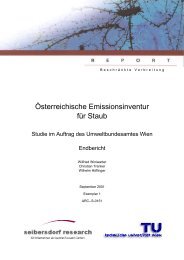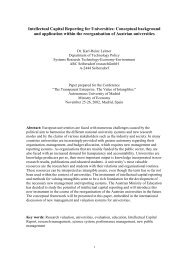ALPMON FINAL REPORT - ARC systems research
ALPMON FINAL REPORT - ARC systems research
ALPMON FINAL REPORT - ARC systems research
You also want an ePaper? Increase the reach of your titles
YUMPU automatically turns print PDFs into web optimized ePapers that Google loves.
Contract ENV4-CT96-0359 <strong>ALPMON</strong><br />
<strong>ALPMON</strong> classes CORINE classes<br />
Sealed surfaces 1.1 Urban fabric<br />
Broad-leaved forest (aggregated) 3.1.1 Broad-leaved forest<br />
Coniferous forest (aggregated) 3.1.2 Coniferous forest<br />
Mixed forest (aggregated) 3.1.3 Mixed forest<br />
Grassland 2.3.1 Pastures<br />
3.2.1 Natural grassland<br />
Shrubs (juniperus, rhododendron) 3.2.4 Transitional woodland shrub<br />
rock/gravel/soil 3.3.2 Bare rock<br />
3.3.3 Sparsely vegetated areas<br />
Snow/ice 3.3.5 Glaciers and perpetual snow<br />
Wet land 4.1.1 Inland marshes<br />
Water 5.1 Inland waters<br />
Applying the transition rules from Table 12 allows for a direct comparison of the two data sets. In order<br />
to enable this comparison the vector based CORINE land cover maps are rasterised with the pixel size<br />
of the <strong>ALPMON</strong> land cover maps. Confusion matrices of the two raster layers give a first idea of the<br />
level of agreement between the data sets. They were also used as reference for generalising the<br />
<strong>ALPMON</strong> classification results as described in the following chapter.<br />
2.3.6.3.2 Spatial generalisation of land cover maps<br />
When comparing thematic maps on a pixel basis the minimum mapping units have to be considered.<br />
Areas that are composed of different land cover types in one map might be generalised to one land<br />
cover type in the other map. In the actual case the minimum mapping unit of CORINE equals 25<br />
hectares, whereas the <strong>ALPMON</strong> results are classified on a pixel basis. Assuming a pixel size of 10m<br />
all regions smaller than 2500 pixels have to be generalised, e.g. an area composed of patches of<br />
coniferous and broad-leaved forest each being smaller than 2500 pixel might be assigned mixed forest<br />
after generalisation.<br />
In order to perform the generalisation two aspects have to be considered. First only those pixels are<br />
processed that belong to regions smaller than 25 hectares. Second the neighbourhood of these pixels<br />
has to be investigated in order to find the proper generalised class for the pixels. This neighbourhood<br />
analysis will be performed applying a so-called post-classification algorithm (Steinnocher 1996).<br />
The algorithm works within a local neighbourhood which is defined by a moving window. Within this<br />
window a standardised histogram of the input classes is calculated, representing the spatial<br />
composition i.e. the frequency of the input classes found in the local neighbourhood. The histogram is<br />
then compared to a set of rules which represents the expected frequency of input classes for each<br />
generalised class. As soon as a rule is found to be true the corresponding generalised class is<br />
assigned to the centre pixel of the window.<br />
Each rule defines the minimum frequency of one or more input classes for one generalised class.<br />
When compared to the corresponding elements in the histogram the frequency values represent<br />
thresholds. If all thresholds are exceeded within a rule, it is recognised as true and the corresponding<br />
secondary class will be assigned. The rules allow for a combination of several sub-rules within one<br />
major rule. Each sub-rule defines a threshold for one or more input classes and all sub-rules have to<br />
be true to accept the major rule. Processing of the rule-set is performed step by step starting at the top<br />
of the set. As soon as a rule is accepted and therefore applied, the rest of the rule-set will not be<br />
considered any more. If no rule is found to be true a rejection class is assigned.<br />
Apart from the design of the rule-set the size of the analysed neighbourhood represents a crucial<br />
parameter in the post-classification process. Choosing a small window size will lead to a ‘noisy’ result<br />
since only high frequency structures will be recognised. If the window is too large the smoothing effect<br />
will become very strong, thus leading to a loss of detail. At this point it has to be noted that the<br />
presented post-classification is a generalisation process and will always suppress details. However, for<br />
the actual application this effect is required for deriving the generalised representation of the CORINE<br />
land cover maps.<br />
The post-classification algorithm was implemented as a C program (postcl.c), and can be easily<br />
implemented under any operating system providing a C compiler. The image format used by the<br />
JR, RSDE, ALU, LMU, Seibersdorf, WSL 61




